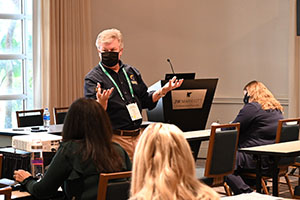
Presenter, Dr. Kevin Pollock, President, Central Carolina Technical College
Live from AACRAO-SEM
Dr. Pollock’s presentation centered on building a strategic recruitment plan with a focus on two-year institutions. Ahead of the session, Dr. Pollock submitted a set of learning objectives that included:
First Learning Outcome: Develop an understanding of marketing and advertising as related to two-year institutions, including a focus on competitive advantages, influences and factors, strategic student searches, and communication plans.
Second Learning Outcome: Learn how to better tell their institution's story, including developing a storytelling kit, strength in specificity, and an elevator speech.
Third Learning Outcome: Learn the fundamentals of building a recruitment plan, including territory management, creating efficiencies in admissions, successful campus events, counselor and community relations, and more.
Opening the session, Dr. Pollock prefaced with a series of statistics relevant to community colleges:
Only 13% of community college students complete a “two-year” degree in two years
Most students who leave community colleges are not academically failing
46% of all U.S. undergraduates attend community college
Looking at “today’s students,” Dr. Pollock encouraged attendees to examine their marketing and recruitment strategies and determine whether their current strategy and focus align with the current data.
Adapt what Works
“If you could take your school right now, and eliminate or change anything you want? Would it look exactly the same as it looks right now”
Next, Dr. Pollock examined the “traditional enrollment funnel” and “building the class.” Two-year community colleges, in particular, focus a lot of time on marketing and advertising. Part of the difficulty for two-year schools is understanding and tracking where students are coming from. “You really need to know, how you know where they’re coming from.”
When marketing, schools need to:
Dr. Pollock also encouraged attendees to ask a couple of questions to understand their competitive advantages, such as:
Continuing, Dr. Pollock went over various tactics used by two-year and four-year institutions to find sources for prospective students.
Simplifying the Process
Examine and ensure that basic questions are being answered on the institution’s website and that the answers are available and easy to find within fewer than two or three clicks.
Ensure that the right message is delivered to the right audience at the right time. Whether this is communications towards freshmen, transfer students, or parents, it is critical that they are receiving specific and tailored information created to fit their needs.
When telling your institution’s story, ensure that it is specific and detailed rather than general. Some examples provided include:
Too General
Specific and Detailed
“Our average class size is 15; though you will often see courses with fewer than 10 students enrolled. You will never be in a class larger than 40.”
“Dr. Xavier from the genetics department cares very deeply about developing students’ special abilities.”
“Our institution is located in upstate New York, known for its outdoor recreation activities year-round.”
Tactics
A significant portion of the session covered the variety of tactics commonly used by two-year institutions, including:
In-field travel
High School Visits
College Fairs
Faculty as Connectors
Counselor Relations
And more
The running theme of differentiation, specificity, and data collection continued through this section.
Conclusion
Attendees were encouraged to outline a communications plan, a recruitment plan, and focus on personal connections at every step in the journey, and consistently promote student engagement.
"If we commit to SEM's human side, it focuses data and prioritizes its use for individual student success"
Interested in joining the discussion? Join AACRAO's small college registrars listserv to stay current, ask questions, and engage with your fellow AACRAO members.